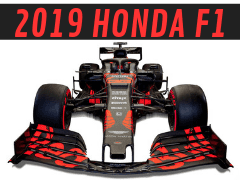2019 marks the second year for Honda's engine partnership with Scuderia Toro Rosso and five years since their return to the grid with famed McLaren team. Since then Honda has suffered countless setbacks coupled with performance and reliability issues. So much that the F1 racing team McLaren cut all ties and moved to use the French engine supplier Renault.
But this is a beginning of a new season and here we are, once again, expecting to see improvements and performance out of the Honda-powered cars. For the first time since their return to the F1 grid, Honda will now supply power units to two teams... Scuderia Toro Rosso and the parent company and last year's 3rd place finisher, Red Bull Racing.
Red Bull Racing
The four-time world champion F1 team, Red Bull Racing (RBR) has switched to Honda power after leaving their previous engine supplier, Renault. RBR hopes to improve their championship-winning chances by being a works team which means they have direct support from the engine supplier. A works team has many advantages compared to just being supplied engines because the Honda Formula One engineers are directly involved with the many key elements of engine design and there is, of course, the funding and cost benefits to RBR.
The new 2019 spec car named the RB15 wears an awesome design put together by RedBull. While this is a launch only design, we wish RedBull would keep it for the entire season!

The 2019 regulations aren't very complex changes but there are major mandates to the front wing section, front bargeboards, and rear wing section. Front wings this year are longer, wider with a maximum of five aerodynamic "elements." This is to prevent teams from running super complex front wings which channel the air in very specific ways.

The idea is that if the cars are less sensitive to front wing aerodynamics and downforce they will be less affected by the aerodynamic wake caused by following close behind another car. They say... this will promote more overtaking.

Without getting too far into the details of the 2019 aero rules, one of the most notable changes other than the front wing is related to the size and shape of the rear wing. Rear wings can now be larger, taller and wider. Not only are they larger, but the DRS flaps are allowed to open more which will give the DRS enabled car a greater advantage which should also support more overtaking. We hope it just isn't too artificial.

Another new feature for 2019 is the two verticle lights on the rear wing section. These lights help drivers see other cars clearer in the rain, they also blink under caution and when the ERS is charging. Pretty cool.
RBR drivers include world champion contender Max Verstappen and the newest RBR driver, Frenchman Pierre Gasly.
Testing begins next week so we will really have a better look at how the new Honda powerplant is going to work but we are excited to see the cars back on track. Maybe Honda will show the progress everyone expects, I just hope it's enough to give RBR a fighting chance.
Scuderia Toro Rosso
The STR14 launched earlier this week and while there are the same rules and regulation changes applied to the car, the overall color and livery scheme remains the same.

Drivers for STR this season include the return of Russian Daniil Kyvat and rookie Alexander Albon.

Honda will have double the amount of technical data this season so hopefully, that will speed up the development process over the couse of the year. We expect to see all cars testing in Spain next week, stay tuned for more! Go Honda!

Credit / Links
